- APDIC >
- Awards & Committees >
- Industrial Award >
- Recipients
Recipients of APDIC Industrial Award
- 2024 - Apple Inc., Cupertino, California, USA
The Alloy Engineering team of Apple Inc. has been using phase diagram information employing CALPHAD-based computational models and tools in the development of enclosure alloys for various consumer electronic products, such as the Apple iPhone, MacBook, iPad and Watch. Key requirements of these alloys include strength, cosmetics, reliability, recyclability, processability, scalability and an aggressive material qualification schedule due to the annual product release cycle. By integrating CALPHAD-based computational models and tools linking process-microstructure-property prediction into the material development and qualification process, the Alloy Engineering team successfully developed several stainless steels and aluminum alloys for iconic Apple electronic products in the past decade, significantly reducing conventionally lengthy prototyping schedules. Apple's outstanding achievements in the application of phase diagrams and strategies for advanced use of materials in products and industrial processes have advanced industry and contributed to our general knowledge and application of phase diagrams.
- 2023 - Usiminas, Brazil
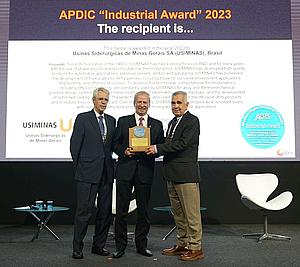
Since its foundation in the 1960’s, USIMINAS has had a strong focus on R&D and for many years, with the use of phase equilibria and computational thermodynamics, USIMINAS has developed high quality products for automotive applications, pressure vessels, and oil and gas piping. USIMINAS has pioneered the development of thick plates for API pipelines, including those for corrosive environment applications, shipbuilding, and offshore structures. To develop this technology, computational thermodynamics, including diffusion modelling, are constantly used by USIMINAS for alloy and thermomechanical process design, optimisation of hot metal treatment and steelmaking for low residuals, and the development of optimised casting conditions. These techniques are also used to improve the life cycle of its products and to reduce environmental impact. Over the last years, USIMINAS has developed wear resistant steels with outstanding structural properties for mining and agricultural applications..
Prof Fernando Rizzo (President of CGEE, Emeritus Professor PUC-RIO), Technical Advisor to APDIC, and Andre Costa e Silva, APDIC IA Committee chair and Brasil´s representative in APDIC had the honor of presenting to Sergio Leite de Andrade, USIMINAS Vice President for Strategic Issues, the 2023 APDIC Industrial Award, during the opening ceremony of the 7th ABM Meeting.
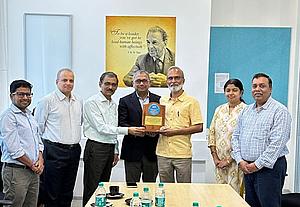 2022 - TATA Steel Ltd. India
2022 - TATA Steel Ltd. IndiaTATA Steel Ltd, India, has a long tradition of using thermodynamic and phase diagram data to improve their processes and products. TATA Steel has since the 1980's supported the assessment and publication of binary, ternary and higher order phase diagrams especially for iron rich systems. TATA Steel makes extensive use of CALPHAD based computational tools in the development of new processes and products, which has resulted in publication of many research papers and patents. These advances are relevant to improving steel manufacturing processes, improving yield and reducing environmental impact. Examples include significant improvements in flat steel products used in the transportation industry, development of thermodynamic control indices to avoid solidification problems, modification of galvanized steel using a precoating with copper that reduces the intermediate layer and the development of Advanced High Strength Steel with an optimized composition reducing the carbon footprint by judicious tailoring of alloying elements.
The APDIC Industrial Award is presented to Dr D. Bhattacharjee, Vice President Technology & New Materials Business, Tata Steel, by Prof. K.C. Hari Kumar, APDIC representative for India, at a function held at the Tata Steel Mobility Center, Research Park, IIT Madras, India.
- 2021 - SAFRAN-Tech, France
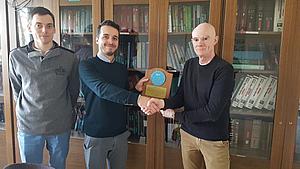
Safran is an international high-technology group operating in the aircraft propulsion and equipment market. Safran-Tech is the Group Research & Technology center located in Saclay, France. In support of their Aircraft Engine Business (Safran Aircraft Engine, formerly Snecma) and their Helicopter Engine Business, Safran-Tech has actively supported and took part in the development of a widely used Thermodynamic Database for Nickel-Based alloys. They have also developed several in-house applications based on thermochemical and mobility databases, to model solidification and other critical steps in the manufacturing of superalloys. In collaboration with Universities, Safran-Tech has used thermodynamics to help develop TiAl and high-entropy alloys and is working in the development of a Numerical Alloy Design approach, combining machine learning tools and CALPHAD modelling.
The award is presented to Edern Menou and Thomas Vaubois of SAFRAN-Tech by Jean-Marc Joubert, the APDIC representative of France.
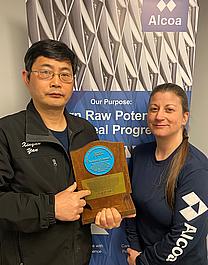 2020 - Alcoa Technical Center, USA
2020 - Alcoa Technical Center, USAFor a number of years, Alcoa Technical Center has used CALPHAD-based computational tools to develop a range of new alloys. These innovative foundry alloys offer improved corrosion resistance, superior strength and new lightweight solutions for the automotive and related industries. These alloys are making a positive contribution to improving the environmental performance of the transportation industry. In addition to alloy development, Alcoa have used CALPHAD modelling in the development of microstructural prediction tools to combat hot tearing, which are now used widely in casting and filler metal industries. New ageing processes have been developed for conventional aluminium alloys, where heat treatment times have been reduced significantly with both economic and environmental benefits.
The APDIC Industrial award is accepted by representatives of Alcoa Technical Centre
- 2019 - Vyksa Steel Works, OMK JSC, Russia
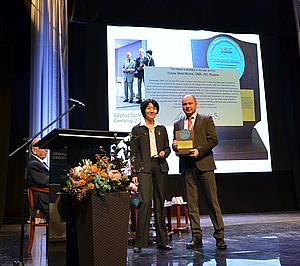
OMK JSC is one of Europe's largest manufacturers of large diameter pipe for pipelines. The Engineering and Technological Centre in the Vyksa Sttel Works, OMK JSC extensively uses thermodynamics and phase diagrams in the development and improvement of materials and processes. Using CALPHAD thermodynamic and kinetic modelling, OMK JSC has successfully developed high strength high toughness pipeline steels for use at very low temperatures. This has resulted in significant reduction in the development time and optimized the use of raw materials and resources in its manufacturing process. Furthermore, more efficient and safe transport of oil and gas has been made possible by the developed steel. OMK JSC sponsors educational and scientific projects as well as scholarships for talented students in materials science. The award is presented to Stepanov Pavel Petrovich, director of the R&D centre, by Alexandra Khvan, APDIC representative of the National committee on Thermal Analysis and Calorimetry, of the Russian Academy of Sciences.
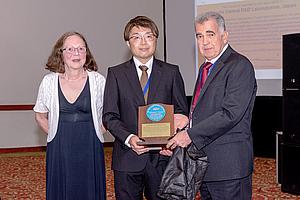 2018 - Toyota Central R&D Laboratories, Japan
2018 - Toyota Central R&D Laboratories, JapanThe Toyota Central R&D Laboratories, Toyota Motor Corporation, are pioneers in materials development to increase efficiency in automotive applications. Developments in structural alloys and many other applications using computational thermodynamics are important examples. Recently, using the Calphad technique, Toyota has developed complex quinary alloys that when laser clad on engine cylinder head ports, greatly enhance their wear resistance while maintaining very high thermal conductivity. This has contributed to the increase of maximum thermal efficiency and specific power of engines. This is an important contribution to sustainability and environmental care.
- 2017 - Tenaris R&D, Campana, Argentina
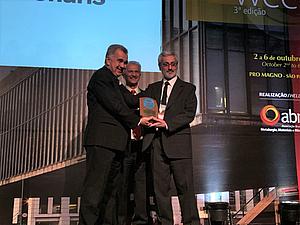
Tenaris is a leading supplier of tubes and related services for the world's energy industry, and has a global R&D network of which Tenaris R&D Campana, Argentina, plays a leading part. Tenaris R&D Campana has used thermodynamic and phase diagram data, together with selected experiments to control non-metallic inclusions, optimise slags for steel refining and produce high quality steels for extreme conditions. The steel compositions are simulated with the use of computational thermodynamics to achieve the optimum combination of properties for materials including low carbon bainitic steels for line pipes, medium and high carbon martensitic steels for oil country tubular goods and tooling respectively, and new high-strength steels with improved low-temperature toughness.
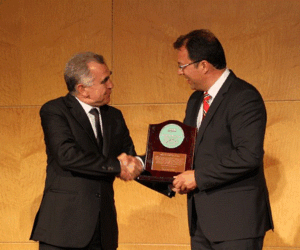 2016 - Vallourec Tubes Group, Germany.
2016 - Vallourec Tubes Group, Germany. The 2016 award goes to the Vallourec Research Centre Germany, which is part of the Vallourec Tubes group, a world leader in the manufacture of high end tubular products, including boiler, heat exchanger and Oil Country Tubular Goods. Vallourec Research has been applying with great success computational thermodynamics, diffusion simulation and similar CALPHAD techniques to alloy and process design, working in close collaboration with their various industrial units around the world. This has made a significant impact in making possible oil and gas production from extreme-condition oil fields, and the design of more efficient and environmental friendly power plants. Vallourec R&D has created an interaction with universities and helped expand the application of phase diagrams to real problems.
 http://www.vallourec.com/EN/group/MEDIA/News/Pages/apdic-award-2016.aspx
http://www.vallourec.com/EN/group/MEDIA/News/Pages/apdic-award-2016.aspx
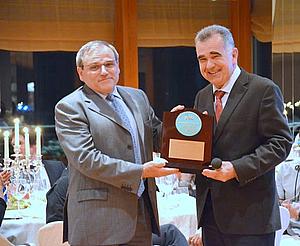 2015 - Ansaldo Energia, Italy
2015 - Ansaldo Energia, ItalyAnsaldo Energia R&D department has developed and applied models that support materials selection and life extension of parts used in high temperature gas turbine and steam turbine plants for energy generation. These tools use thermodynamics to predict phase evolution in Ni and Co based superalloys, Ni-Co-Cr-Al-Y coatings and thermal barrier coatings (TBC). They have been applied extensively with a high degree of success to several components and parts of gas and steam turbines and have made it possible to increase energy efficiency, extend useful life and avoid costly failures in equipment critical to energy generation. These tools are also essential in the design of new and energy efficient equipment.
Franco Rosatelli, Chief Technical Officer of Ansaldo Energia (left) is presented with the award for 2015 by Andre Costa, chair of the Industrial Awards Committee (and past chair of APDIC).
- 2014 - The Zhuzhou Smelter Group, China.
The 2014 award goes to the Zhuzhou Smelter Group for the "application of thermodynamics to zinc alloy design and coating quality and improvement in galvanising". This has involved the experimental determination and calculation of phase equilibria for Zn alloys with particular emphasis on the behaviour of additions of Si. This has culminated in the use and development of software to manage the production of new zinc alloys and the control of carbon precipitation to improve the adhesion characteristics of galvanic coatings on steels.
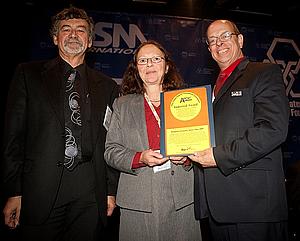 2013 - Swagelok, USA
2013 - Swagelok, USAThe APDIC Industrial Award 2013 was presented to the Swagelok Company, Solon, Ohio, USA, during the Leadership Awards Luncheon of ASM International in Montréal, Québec, Canada, on October 28, 2013. The Award was presented by Patrice Turchi, Chair of the ASM Alloy Phase Diagram Committee and ASM representative to APDIC, and Ursula Kattner, APDIC Vice Chair, to Peter Williams, Swagelok Chief Scientist. Swagelok is being recognized for developing a new surface hardening method for the carburisation of austenitic stainless steels using a low-temperature supersaturation process during which the formation of carbides is kinetically suppressed thereby allowing extremely high solubility of carbon in the steel. This process was developed in collaboration with researchers from Case Western Reserve University and utilises phase equilibria information, thermodynamic modeling with the CALPHAD method and other methods to evaluate paraequilibria. As a result Swagelok has been able to develop new stainless steels with improved wear resistance leading to vast improvements in component life and associated significant cost savings.
- 2012 - TELE AND RADIO RESEARCH INSTITUTE, Warszawa, Poland.
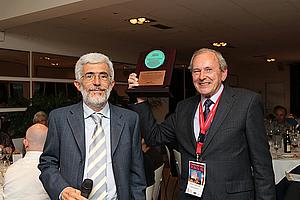
Tele and Radio Research Institute (ITR) is a leading research and development institution which plays a bridging role between science and industrial applications in Polish electronics. For the last 30 years ITR has been committed to the development of environmentally safe solder materials for the electronics industry with a strong emphasis on phase diagram evaluation, assessment and experimental determination .The work of ITR has led to more than 12 patents in this area, including important work on the development of lead-free solders, solder pastes and assessments of the environmental benefits associated the use of such alloys.
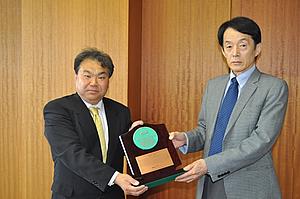 2011 - HITACHI, Japan
2011 - HITACHI, Japan Hitachi has applied techniques for the calculation of phase equilibria from critically assessed thermodynamic data in order to accelerate the development and evaluation of high temperature materials for gas and steam turbines. Since 2000 Hitachi has developed two epoch-making superalloys, FENIX-700 and USC800, for high temperature steam turbines. The base material of FENIX-700 is Alloy706 and Hitachi has succeeded in improving both its microstructural stability and segregation properties. USC800 is a new material developed using computational thermochemistry to balance high temperature strength with the manufacturability of a large forging by decreasing the solvus temperature of the Ni3Al phase and increasing the amount of Ni3Al at service temperatures, resulting in higher creep strength.
Prof Tetsuo Mohri (Hokaido University) delivers the 2011 Industrial Award to a Hitachi senior research executive at Hitachi Tokyo headquarters.
- 2010 - Sandvik AB, Sweden
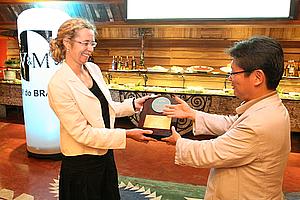
Sandvik has long been a pioneer in the use of techniques for the calculation of phase diagrams from critically assessed thermodynamic data in support of alloy development both in terms of the development of steels and cemented carbides. It was the first industrial organisation anywhere in the world to base new alloys from results of thermodynamic calculations carried out in the early 1980's and now references thermodynamic calculations as one of its most important research and development tools. Sandvik has continued to be a strong supporter of such activities.
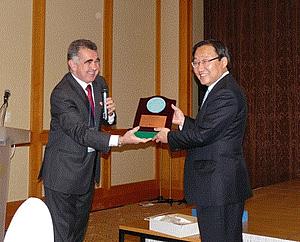 2009 - POSCO Steel, Korea
2009 - POSCO Steel, KoreaPOSCO uses thermodynamic data to calculate phase equilibria to predict the microstructure and mechanical properties of steels during hot rolling processes. Powerful software is used with commercial and in-house thermodynamic databases, supplemented by ab-initio calculations and molecular dynamics simulation, for the construction of a multi scale modelling framework and to optimise the design of alloys and processing parameters. The range of applications is being extended to plate and wire rod rolling processes.
- 2008 - Villares Metals S.A., Brazil
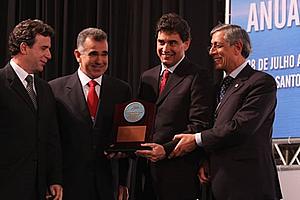
For more than 40 years, Villares Metals has combined the use of phase diagrams, thermodynamic information and critical experiments for the improvement of processing and quality of specialty steels. This has led to the development of:
engine valve steel with outstanding control of chemistry and non-metallic inclusions
improved hot and cold work tool steel compositions for extended tool life and performance
advancements in electroslag and vacuum arc re-melting, including the introduction of hydrogen control in the 1970's and process control developments which have expanded the range and quality of alloys produced.
 2007 - Rolls Royce Aerospace Engines, England
2007 - Rolls Royce Aerospace Engines, EnglandThe search for ever greater performance from a modern gas turbine is the subject of constant scientific investigation. Rolls-Royce plc has long been at the forefront of such research. In recent years, it has pioneered the use of calculated phase equilibria for Ni-based superalloys and titanium aluminides in order to assist in the development of new materials and the control of alloy chemistry. This has dramatically reduced the need for traditional experimental work and the development time required to introduce new commercial alloys into current and new engines.
President of the Institute of Materials, Minerals and Mining, Dr. Richard Dolby (right), presenting the 2007 APDIC Industrial Award to Colin J. Small, Rolls-Royce plc.
2006 - ArcelorMittal Research (ARSA), formerly IRSID, France
2005 - Baoshan Iron & Steel Company, Ltd of Shanghai, China

Over the last few years Baoshan Iron and Steel Co Ltd have combined state-of-the-art calculations involving thermodynamics and kinetics coupled to high precision experimental work towards the development of new and improved materials. This work includes design and development of new types of TRIP steel, prediction of the degradation of CeO2 in ZrO2-CeO2 ceramics for automotive exhaust systems, systematic development of phase diagrams for hard metal alloy systems and improvement of the machinability of large section pre-hardened, mould steel for the plastics industry.
2004 - FE Steel Corporation & QuesTek Innovations
2003 - Nippon Steel Corporation
